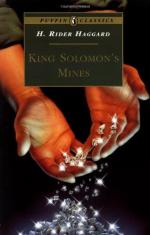I had better leave the feelings of intense excitement with which we set out on our march that morning to the imagination of those who read this history. At last we were drawing near to the wonderful mines that had been the cause of the miserable death of the old Portuguese Dom three centuries ago, of my poor friend, his ill-starred descendant, and also, as we feared, of George Curtis, Sir Henry’s brother. Were we destined, after all that we had gone through, to fare any better? Evil befell them, as that old fiend Gagool said; would it also befall us? Somehow, as we were marching up that last stretch of beautiful road, I could not help feeling a little superstitious about the matter, and so I think did Good and Sir Henry.
For an hour and a half or more we tramped on up the heather-fringed way, going so fast in our excitement that the bearers of Gagool’s hammock could scarcely keep pace with us, and its occupant piped out to us to stop.
“Walk more slowly, white men,” she said, projecting her hideous shrivelled countenance between the grass curtains, and fixing her gleaming eyes upon us; “why will ye run to meet the evil that shall befall you, ye seekers after treasure?” and she laughed that horrible laugh which always sent a cold shiver down my back, and for a while quite took the enthusiasm out of us.
However, on we went, till we saw before us, and between ourselves and the peak, a vast circular hole with sloping sides, three hundred feet or more in depth, and quite half a mile round.
“Can’t you guess what this is?” I said to Sir Henry and Good, who were staring in astonishment at the awful pit before us.
They shook their heads.
“Then it is clear that you have never seen the diamond diggings at Kimberley. You may depend on it that this is Solomon’s Diamond Mine. Look there,” I said, pointing to the strata of stiff blue clay which were yet to be seen among the grass and bushes that clothed the sides of the pit, “the formation is the same. I’ll be bound that if we went down there we should find ‘pipes’ of soapy brecciated rock. Look, too,” and I pointed to a series of worn flat slabs of stone that were placed on a gentle slope below the level of a watercourse which in some past age had been cut out of the solid rock; “if those are not tables once used to wash the ‘stuff,’ I’m a Dutchman.”
At the edge of this vast hole, which was none other than the pit marked on the old Dom’s map, the Great Road branched into two and circumvented it. In many places, by the way, this surrounding road was built entirely out of blocks of stone, apparently with the object of supporting the edges of the pit and preventing falls of reef. Along this path we pressed, driven by curiosity to see what were the three towering objects which we could discern from the hither side of the great gulf. As we drew near we perceived that they were Colossi of some sort or another, and rightly conjectured that before us sat the three “Silent Ones” that are held in such awe by the Kukuana people. But it was not until we were quite close to them that we recognised the full majesty of these “Silent Ones.”




